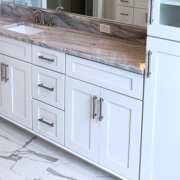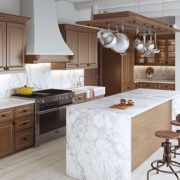Match Your Bathroom Vanity to Bathroom Tile
Upgrading your bathroom can be an exciting process. Being able to choose your very own design and watch as it transforms makes renovation much more gratifying. However, going through the decision making process can be stressful. Which shower tiles will look best with the atmosphere? Which bathroom vanity will complement your flooring? All is very important when it comes to interior design, and each will play a huge role in meeting your satisfactory needs. In this article, we will get into depth on how to go about matching your bathroom vanity to your bathroom tile.
Bathroom Vanity: Where Do You Start?
There is no right or wrong way to design your living space. But first, what exactly is a bathroom vanity? Vanities are generally a combination of the bathroom basin (or sink) as well as the storage that surrounds it. They are popularly one of the most important details in bathroom design and serve as the centerpiece of the space. Fortunately, vanities can be made with many different materials. As far as the countertop, you can choose between the following:
- Stone
- Laminate
- Cement
- Wood
If you want your flooring installed around your vanity or underneath, be sure to keep the following guidelines in mind when it comes to each option.
Tile Before Bathroom Vanity
Installing tile flooring underneath a bathroom vanity saves you from the process of sealing or caulking fill gaps and perimeter joints that may remain after installation. With tile flooring already installed, you can decide on various vanity sizes of your preference. Another important benefit of installing tiles underneath the vanity is having more flexibility on future remodels or renovation.
Installing Tile After Vanity
The most important benefit of installing tile after a bathroom vanity is the ability to replace or change the flooring in the future without having to entirely remove the vanity. In addition, installing the vanity prior to flooring minimizes the downward pressure of the cabinetry to the ground. This order also reduces the risk of damage to your flooring during the vanity installation.
Deciding on Flooring
Prior to anything, you want to have a theme in mind for your bathroom design. Are you aiming towards darker colors or lighter? Are you considering using both to create accents and contrast? If your vanity is meant to be the alluring factor of the room, certainly choose flooring that is far lighter or darker than that of the vanity. For example, darker flooring against a white vanity or lighter flooring against a darker vanity will help to accentuate and emphasize the vanity as a whole. Use your bathroom vanity to make a statement when you choose your flooring. Contrast creates visual appeal and brings depth into the space.
Complementary Mindset
Another design preference is through matching colors. This route will give your bathroom a sense of unity and solidarity. Rather than using your bathroom vanity as an accent piece, you can use it to complement the rest of the appliances. You can accomplish this by using different shades of the same color, for example, light grey tile flooring partnered with a dark grey vanity.
Contact Go Mobile Flooring
Consult Go Mobile Flooring for all your renovation questions and ideas. Allow us to assist you throughout your decision making when it comes to upgrading any part of your home. Whether your bathroom, living room, kitchen, or patio, we’ve got all the tools needed to provide you with great quality materials to build upon. Our selection of hardwood, laminate, tile, vinyl, and carpet are abundant. So don’t hesitate to visit our website or contact us to get your project started.












